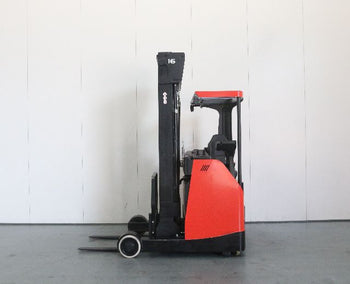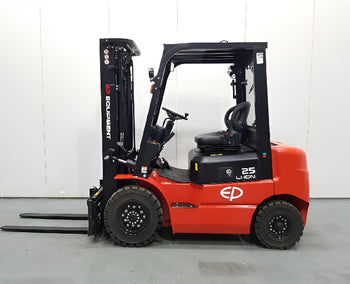The United Kingdom’s materials‑handling sector is changing rapidly as businesses seek more sustainable and cost‑effective ways to move goods. Electric forklifts are at the heart of this shift because they emit no exhaust fumes, have lower operating costs and offer modern features such as telematics and lithium‑ion batteries. This article analyses the 2025 market for used electric forklift UK equipment, explains pricing trends and offers buyer advice. It also highlights iLift’s electric pallet trucks as a leading solution for companies that want reliable and efficient handling equipment.
UK forklift market growth driven by e‑commerce and warehousing
The value of the UK forklift market is expected to continue growing significantly. Grand View Research forecasts that the UK forklift market could be worth around US$14.2 billion (≈£11.6 billion) by 2030, expanding at an annual rate of about 15.4 % from 2025. This growth is fuelled by structural changes in the logistics sector.
According to TechSci Research, the growth of online shopping has led to a 61 % increase in the number of warehouses since 2015; the number of facilities larger than 1 million sq ft has risen 345 %, and 60 % of online orders are now placed via mobile devices. In 2025, British e‑commerce sales are expected to reach US$235 billion, making up 30.7 % of retail spending. The boom in online retail, coupled with greater pressure to fulfil orders quickly, has created a strong demand for forklifts and particularly for electric models that can operate indoors without emissions.
Government incentives and corporate sustainability targets also support the adoption of electric forklifts. Electric models offer low emissions, lower noise levels and lower maintenance requirements than internal combustion (IC) machines. Innovations such as telematics, Internet‑of‑Things (IoT) integration and advanced battery management systems are increasingly important: telematics help fleet managers monitor battery status and prevent downtime, while IoT sensors optimise maintenance schedules. Although the UK’s planned ban on petrol and diesel cars has been delayed to 2035 and currently applies mainly to passenger vehicles, the policy signals a long‑term shift away from combustion engines and encourages businesses to consider electric options.
Why buy a used electric forklift?
While new electric forklifts offer the latest features, buying used equipment can be a smart way to reduce costs and environmental impact. Verified Market Reports estimates that the global used and refurbished industrial electric forklift market is worth approximately US$3.2 billion in 2024, and it is forecast to reach US$5.1 billion by 2033, reflecting a compound annual growth rate of 5.5 %. The report notes that used and refurbished machines provide high performance at a lower price and help companies meet sustainability targets. Refurbishment processes involve a thorough inspection, replacement of wear parts and testing to ensure safety and reliability. Global demand for electric forklifts is rising because they reduce carbon footprints and meet stricter environmental regulations.

Cost advantages and operational savings
TCM’s comparative analysis shows that a new 2.5‑tonne electric forklift costs around £25,000, while a comparable diesel model costs about £20,000. Although the initial purchase price of electric equipment is higher, the operating cost per year is much lower—electric forklifts cost roughly £2,000–£3,000 per year to operate compared with £5,000–£6,000 per year for diesel models. Maintenance is also cheaper: electric forklifts average £1,000 per year in upkeep versus £1,600 or more for diesel units. When calculated over the life of the machine, these savings mean electric fleets can reduce daily running costs by up to 50 %.
Environmental and performance benefits
Electric forklifts produce zero tailpipe emissions, making them ideal for indoor use and helping businesses align with environmental regulations. Battery technology has advanced considerably; lithium‑ion batteries provide longer run‑times, faster charging and no memory effect. TechSci Research highlights the adoption of lithium‑ion batteries and telematics as major trends in the UK forklift market. Moreover, the absence of an internal combustion engine means electric forklifts have fewer moving parts and require less maintenance, leading to higher reliability and less downtime.
Pricing trends: new vs used electric forklifts in 2025
The price of a used electric forklift depends on capacity, age, battery type, brand and hours of use. Examples from UK dealers illustrate typical ranges:
-
Used 2.5‑tonne electric forklifts – TCM notes that reconditioned 2.5‑tonne electric forklifts typically sell for £8,000–£10,000.
-
Smaller capacities (1–1.5 tonnes) – On , a 1.3 tonne refurbished electric forklift is listed at £8,750, a 1.5 tonne model costs £4,750, and a Linde E15 (1.5 tonnes) is priced at £5,995. Another 1.5 tonne R20‑15 model costs £6,995.
-
Medium capacities (2 tonnes) – Used Forklifts offers a 2 tonne R20‑20 for £5,995 and a more modern 2 tonne model up to £12,995. These prices reflect differences in age, features and battery technology.
-
Low‑capacity pallet stackers – West Mercia’s listing shows Linde L12 and L16 pallet stackers priced around £2,950 each, illustrating that smaller electric handling equipment can be very affordable.
Chart: Average new vs used electric forklift prices
The following bar chart summarises average prices of new and used electric forklifts by category. The data are drawn from the sources above and provide a visual comparison of typical price ranges.

Figure 1: Comparison of average prices for new and used electric forklifts based on capacity. New 2.5‑tonne electric forklifts cost around £25,000, while reconditioned 2.5‑tonne machines are typically £9,000. Smaller used forklifts (1–1.5 tonnes) average £6,750, and medium‑capacity used forklifts (2 tonnes) average £8,330.
Factors influencing pricing
-
Capacity and lift height: Larger machines with higher lift heights command higher prices because they require bigger, more powerful batteries and motors.
-
Age and usage: Forklifts with fewer operating hours and more recent manufacture dates command premiums. Modern features such as regenerative braking and advanced control systems may also increase value.
-
Battery technology: Lithium‑ion batteries cost more but offer longer life, faster charging and opportunity charging (topping up during breaks). Lead‑acid batteries are cheaper but require regular watering and equalising.
-
Maintenance history: A comprehensive service history (e.g., proof of LOLER inspections and maintenance records) indicates the machine has been cared for and increases buyer confidence.
-
Brand and availability: Popular brands such as Linde, Toyota and EP hold their value well. Supply‑chain disruptions during the pandemic reduced new forklift availability, so the used market has become more attractive; Forklift‑International reports that the supply of high‑performance used forklifts has increased significantly, offering more affordable options.
What about the internal combustion ban?
The UK government originally planned to ban the sale of new petrol and diesel cars by 2030, but this has been delayed to 2035 and currently applies mainly to passenger cars. Industrial vehicles such as forklifts are not yet included, but the policy demonstrates a broader move towards low‑emission vehicles. As sustainability goals become stricter, companies that invest in electric equipment now may avoid future regulatory headaches.

Buyer advice for second‑hand electric forklifts
Purchasing a used electric forklift requires due diligence to ensure the equipment meets your operational needs and safety standards. Key considerations include:
-
Define your application: Determine the load capacity, lift height and aisle width requirements. Over‑specifying can lead to higher purchase prices, while under‑specifying could result in insufficient performance.
-
Inspect the battery: The battery is the most expensive component. Ask for the age of the battery, its ampere‑hour capacity and whether it is lead‑acid or lithium‑ion. Check for corrosion and ensure the charger is included.
-
Examine maintenance records: Reputable dealers will provide documentation of regular servicing and LOLER (Lifting Operations and Lifting Equipment Regulations) inspections. Look for proof that high‑wear items such as tyres, forks, chains and hydraulic hoses have been replaced.
-
Check hour meter and usage: A forklift with low hours (e.g., under 5,000 hours) will generally have more life left than one with 10,000 hours. However, hours should be considered alongside maintenance history; a well‑maintained machine can outlast a neglected one.
-
Assess attachments and safety features: Ensure the forklift has necessary attachments (side shifter, fork positioner, etc.) and safety devices (reverse alarms, lights, seat belts). Modern electric forklifts may include telematics or fleet‑management systems.
-
Verify warranty and dealer reputation: Many dealers offer limited warranties on used forklifts. Check the length and coverage of the warranty and read reviews to ensure the dealer has a good reputation for after‑sales support.
Buying from a trusted supplier ensures that the forklift is refurbished to a high standard, meets safety regulations and offers ongoing support. Avoid purchasing equipment with unknown history or from unverified sources as hidden faults can lead to costly repairs or safety issues.
iLift electric pallet trucks – a sustainable solution
iLift is a UK‑based supplier specialising in electric pallet trucks and handling equipment. Their range showcases the benefits of electric technology and provides versatile options for businesses of all sizes:
-
Affordable entry‑level models: The EPL1531 pallet truck (1.5 tonnes) is priced around £1,200, offering a cost‑effective solution for moving pallets. The F Series pallet truck (1.5 tonnes) starts from £750, making electric handling accessible for small businesses.
-
Medium‑duty trucks: The EPL154/185 models (1.5 or 1.8 tonnes) start from £2,750, while the EPT WA series (2–2.5 tonnes) begins at about £6,000. These machines combine compact size with lithium‑ion batteries, allowing quick charging and plug‑and‑play battery swaps.
-
High‑capacity and rider models: For heavier loads, the KPL201(H) (2 tonnes) costs about £7,500 and the RPL201/251/301 series (2–3 tonnes) start at £6,100. These include platforms for operators to ride on, improving productivity over longer distances.
-
Ex‑demo opportunities: iLift also sells ex‑demo models at reduced prices—for example, the EPL185 ex‑demo is around £1,750.
iLift emphasises that electric pallet trucks are eco‑friendly, quiet and versatile, making them suitable for distribution centres, supermarkets, and manufacturing lines. Their trucks use lithium‑ion batteries that allow opportunity charging and reduce maintenance compared with lead‑acid alternatives. All equipment is supplied with LOLER certification, and iLift offers global shipping, training and maintenance support. The company notes that electric pallet trucks can move up to 2,000 kg, whereas manual pallet trucks typically handle under 600 kg, demonstrating significant productivity gains.
Find Your Ideal Electric Forklift
If you’re considering a used electric forklift UK for your warehouse or manufacturing facility, iLift can help you navigate the options and find the right solution. Explore their full range of electric pallet trucks at iLift’s website or contact their experts for tailored advice. Investing in efficient electric handling equipment today will reduce your operating costs, support sustainability goals and prepare your business for the logistics challenges of tomorrow.





